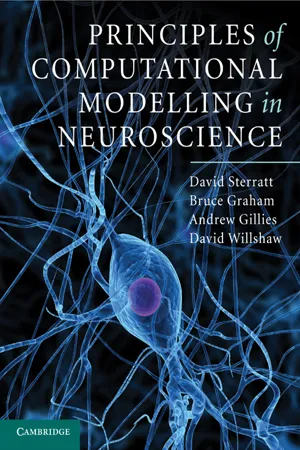
Principles of Computational Modelling in Neuroscience
- English
- PDF
- Available on iOS & Android
Principles of Computational Modelling in Neuroscience
About this book
The nervous system is made up of a large number of interacting elements. To understand how such a complex system functions requires the construction and analysis of computational models at many different levels. This book provides a step-by-step account of how to model the neuron and neural circuitry to understand the nervous system at all levels, from ion channels to networks. Starting with a simple model of the neuron as an electrical circuit, gradually more details are added to include the effects of neuronal morphology, synapses, ion channels and intracellular signalling. The principle of abstraction is explained through chapters on simplifying models, and how simplified models can be used in networks. This theme is continued in a final chapter on modelling the development of the nervous system. Requiring an elementary background in neuroscience and some high school mathematics, this textbook is an ideal basis for a course on computational neuroscience.
Frequently asked questions
- Essential is ideal for learners and professionals who enjoy exploring a wide range of subjects. Access the Essential Library with 800,000+ trusted titles and best-sellers across business, personal growth, and the humanities. Includes unlimited reading time and Standard Read Aloud voice.
- Complete: Perfect for advanced learners and researchers needing full, unrestricted access. Unlock 1.4M+ books across hundreds of subjects, including academic and specialized titles. The Complete Plan also includes advanced features like Premium Read Aloud and Research Assistant.
Please note we cannot support devices running on iOS 13 and Android 7 or earlier. Learn more about using the app.
Information
Table of contents
- Cover
- Principles of Computational Modelling in Neuroscience
- Title
- Copyright
- Contents
- Abbreviations
- Preface
- Acknowledgements
- Chapter 1: Introduction
- Chapter 2: The basis of electrical activity in the neuron
- Chapter 3: The Hodgkin–Huxley model of the action potential
- Chapter 4: Compartmental models
- Chapter 5: Models of active ion channels
- Chapter 6: Intracellular mechanisms
- Chapter 7: The synapse
- Chapter 8: Simplified models of neurons
- Chapter 9: Networks of neurons
- Chapter 10: The development of the nervous system
- Chapter 11: Farewell
- Appendix A: Resources
- Appendix B: Mathematical methods
- References
- Index
- Blank Page